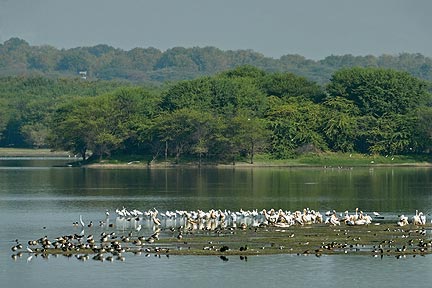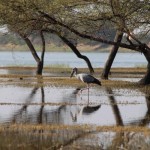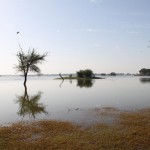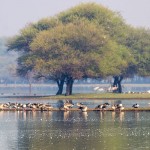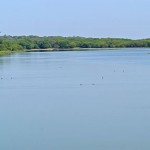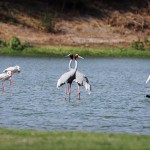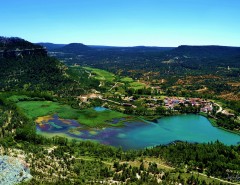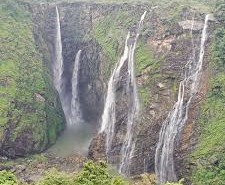Thol Lake is an artificial lake near Thol village in Kalol in Mehsana District in the Indian state of Gujarat. It was constructed as an irrigation tank in 1912. It is a fresh water lake surrounded by marshes. It was declared the Thol Bird Sanctuary in 1988; it is a habitat to 150 species of birds, about 60% are waterbirds. Many migratory birds nest and breed in the lake and its periphery. The two most prominent species of birds recorded in the sanctuary are flamingoes and sarus crane (Grus antigone). The sanctuary is also proposed to be declared an Eco-Sensitive Zone, conforming to the Environment (Protection) Act, 1986 (29 of 1986), for which draft notification has been prepared.
Topography
The lake drains a catchment area of 15,500 hectares (38,000 acres). It is in a semi-arid zone of the Mehsana district with dominance of dry deciduous vegetation.
The climate in the area consists of three seasons: winter, summer and monsoon. The average annual rainfall in the catchment of the lake is 600 millimetres (24 in) with a minimum of 100 millimetres (3.9 in) and maximum of 800 millimetres (31 in). The maximum and minimum temperatures recorded in the area are 43 °C (109 °F) and 8 °C (46 °F).
The lake is situated near Thol village 20 kilometres (12 mi) from Kalol and 40 kilometres (25 mi) north-west of Ahmedabad, 75 kilometres (47 mi) from Mehsana in Mehsana District.
History
The lake was initially built in 1912 as a tank by the Gaekwad regime to provide irrigation facilities to farmers. This established the user rights of the lake water. The operation and management of the lake is under the dual control of the Forest and Irrigation departments of the Government of Gujarat.
Features
The lake has a storage capacity of 84 million cubic metres (3.0×109 cu ft). Its water spread area is 699 hectares (1,730 acres). Lake’s shore length is 5.62 kilometres (3.49 mi) and water depth is shallow.
- Country – India
- State – Gujarat
- District – Mehsana

